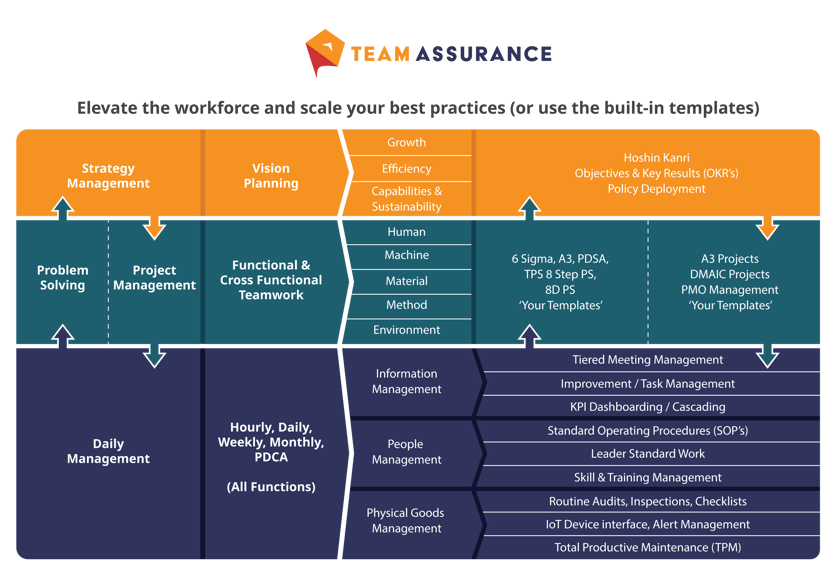Clarity is Key to Strategy Execution

As Brene Brown says: “clear is kind and kind is clear” - we discuss why clarity should be baked into organisational culture for effective strategy execution.
Clarity in our environment is a fundamental tenant of any improvement and sustained success. Yet all too often we find ourselves in a world of assumption, fuzzy boundaries and grey areas that make life difficult for people, process and customers alike.
Establishing and maintaining a currency of clear standards across all facets of our process environment is critical. Clarity here drives the creation of robust processes that repeatably deliver the desired outcomes of our production or service. These standards not only apply to our product quality and the processing or service method. They apply just as much, if not more so, to the expectations of performance and behaviour. All too often leaders and organisations fail to deliver on these which ultimately sets people up for failure, mediocrity and ongoing frustration.
Strategy execution requires clarity
People are products of their environment. If that environment lacks clarity on its purpose, direction, structure, expectations (internal and external), boundaries, and required discipline we cannot hope to achieve a culture of high performance. We cannot hope to achieve a culture of learning and improvement either.
In many instances people are crying out for leadership and direction; they're crying out for support and consistency. Yet all too often the message does not translate, the goal posts shift or the organisation simply does not know what to do or how to do it. Being clear helps us to cut through all of this unnecessary noise, wasted time, effort and suboptimal behaviour.
Being clear starts with our overall goals and objectives. Who are we as an organisation? What is our purpose? Where do we want to go and how do we think we will get there? What are our core values?
It means that we are clearly defining the structure of our business, the roles and responsibilities that lie within it and the level of performance that we expect from our team. We need to ensure that everyone has input and ownership. Everyone needs to clearly understand these key facets and people need to be super clear on how their component part of the bigger picture contributes to team function and the overall goals.
Great cultures thrive on clarity
We have to break it down to the point that every single task or behaviour has intention and purpose. It all must be clearly aligned with developing the daily habits and focus that create an environment capable of propelling us forward.
Clarity requires clear communication and constant messaging. It requires an environment that speaks to us verbally, visually and engages our hearts and minds. This emotionally connects us to the cause, and to other people. It also defines how we need to interact with the environment itself.
Clarity of purpose should be the fundamental building block of standardisation and improvement – What are we trying to achieve? How are we trying to achieve it? What are the standards that must be observed in order for us to meet the requirements? How can we highlight any problems or deviations we may have?
From a purely cultural viewpoint clarity is a must – great cultures thrive on clarity. Cultures can fester and deteriorate over time simply due to a lack of clarity. The same goes for clarity that exists without exposure and accountability. Teams and individuals should be provided with clearly defined and repeated messaging around expectations, combined with accountability through exposure and good quality feedback mechanisms. This must all be facilitated by leadership in order to sustain and lift performance. We are also then well-situated to highlight, and correct, suboptimal performance and behaviours.
Toxic culture impedes strategy execution
Left unchecked, poor performance and behaviour can become toxic to an organisation. They set the bar low and allow incongruence within the population. This inevitably leads to frustration, migration, and a tangible lack of stimulus to change, learn or improve. In any population we will observe natural variation. The level of performance/behaviour will be distributed in a bell shaped curve.
Let’s say that the distribution sits across a scale of 0 to 10. If we are not clear on where we want to be we will typically see a spread from 9 to 2 with a mean of perhaps 4 or 5. This means we are allowing people in our environment that are 2s and 3s out of 10 to comfortably function without intervention. This leaves a wide range of performances from best to worst. People at the 8 and 9 out of 10 are generally self-starters that just do the right things and get on with it. But, they have a limited lifespan when they are the people carrying the burden, looking over their shoulder at the people dragging them down.
The 4s and 5s of the world are simply going to happily remain there – until we begin to move the ’s and 3s up the scale – because there is no reason or stimulus. The point being: nothing changes unless we are clear on expectations and are active in ensuring those expectations are consistently met through accountability and feedback.
This is not about taking punitive action, creating an environment that is all stick and no carrot. This is about clearly defining and communicating expectations. It is about doing everything we can to support and develop people to meet those standards successfully. Our ability to set a standard – maybe that’s an 8 and narrow the range so that a baseline is 6 - ensures we lift and consistently maintain our expectations. It creates a process environment that provides clarity from the moment you walk in the door.
This is where being clear is being kind. In an ambiguous environment many people simply do not know what is expected. It is not fair or showing respect to people for them to guess, to make it up as they go and hope for the best. When we can provide clarity across the board then the conversation changes. Clarity creates inclusion, connection and understanding. It helps to drive curiosity and critical thinking and it ultimately helps people to optimise their time and effort toward the right objectives. Clarity is ultimately key to effective strategy execution.
View strategy execution as part of the greater C.I. Framework
For effective strategy execution we must ensure alignment of all the people, processes and systems involved. Lean tools like standardised problem solving techniques, Standard Operating Procedures (SOPs), and a Tiered Daily Management process that supports the entire PDCA loop are key to achieving strategy success.
The illustration below demonstrates how we designed the interconnected TeamAssurance platform to avoid locally optimised, disconnected ‘Point Solutions’ (digital or analog) that do not help, and may even hinder your organisation’s strategy deployment goals.

Bake in clarity of purpose, vision and process with TeamAssurance. If you’re a business in need (or a consultant with clients in need) and you'd like to explore the opportunities that digital-aids to Lean tools provide contact us for a demonstration today.

